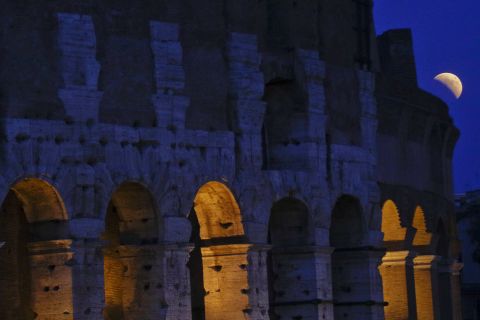A total lunar eclipse -- the longest of the century -- was visible Friday night across much of the Eastern Hemisphere.
The moon appeared red in the night sky as it moved into Earth's shadow, perfectly aligned with Earth and the sun.
Totality lasted about an hour and 43 minutes, and a partial eclipse could be seen before and after that.
Those in North America and other parts of the Western Hemisphere were out of luck, as the eclipse happened during daytime hours there.
The silhouettes of people can be seen before the totally phase of the eclipse in Van, Turkey.
Ozkan Bilgin/Anadolu Agency/Getty Images
The full moon rises behind a youth hostel in Bernkastel-Kues, in western Germany.
HARALD TITTEL/AFP/Getty Images
A partial lunar eclipse, as seen from Gaza City on Friday, July 27.
Hatem Moussa/AP
The blood moon is seen behind a mountain in Lucerne, Switzerland.
Christian Merz/AP
This composite photo shows several images of the moon as it goes though the different stages of the eclipse. The photos were taken in Bishkek, Kyrgyzstan.
Vyacheslav Oseledko/AFP/Getty Images
The moon peeks out next to the Colosseum in Rome.
Gregorio Borgia/AP
The blood moon is framed by the statues of Hera and Apollo in Athens, Greece.
Aris Messinis/AFP/Getty Images
The eclipse as seen from Ankara, Turkey.
Ercin Top/Anadolu Agency/Getty Imagesages
Joining the red moon in the sky Friday was the red planet Mars, as seen on the lower left of this photo taken in Islamabad, Pakistan. Mars is closer to Earth than it has been in 15 years.
Aamir Qureshi/AFP/Getty Images
People watch an early phase of the eclipse from Warsaw, Poland.
Radek Pietruszka/PAP/EPA
A view of the eclipse from Najaf, Iraq.
Haidar Hamdani/AFP/Getty Images
A woman in Taipei, Taiwan, uses a telescope to get a closer look at the phenomenon.
Billy H.C. Kwok/Getty Images
The moon is seen from Nicosia, Cyprus, as the eclipse began to become visible.
Amir Makar/AFP/Getty Images














Comments
Post a Comment